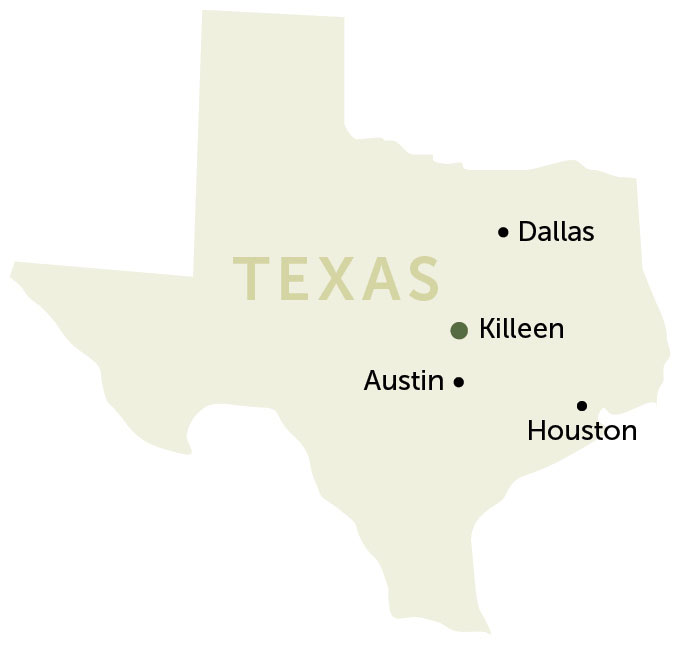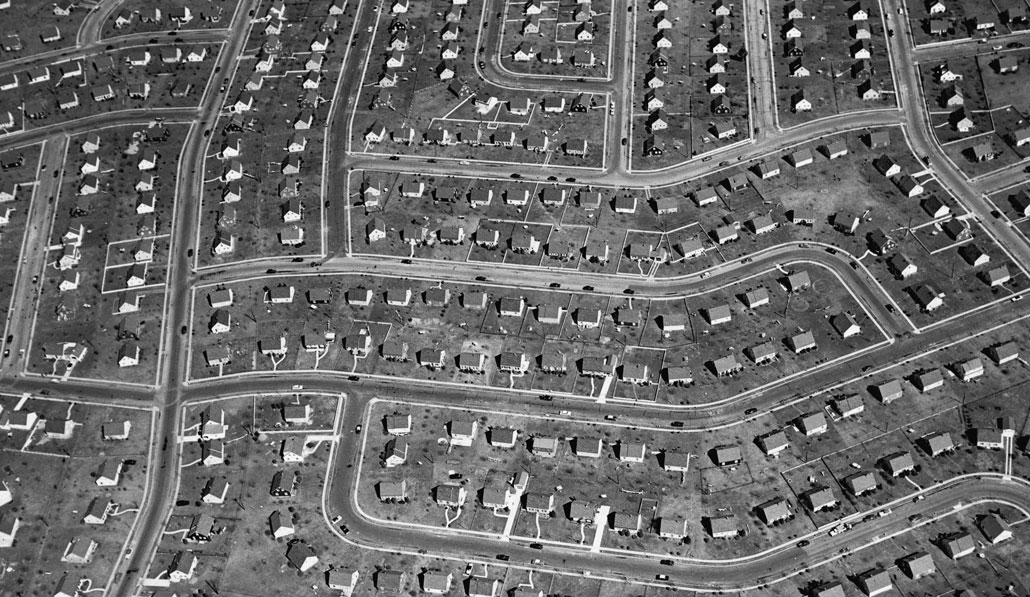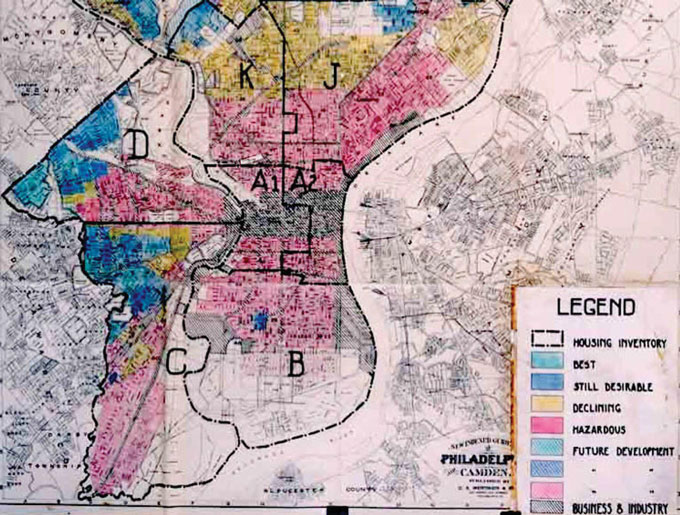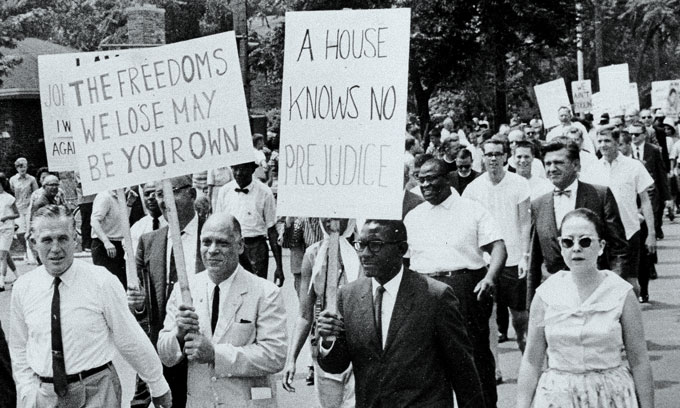This post was originally published on this site
Amber Williams and her husband bought their first house in 2008 for $80,000 in the small military city of Killeen, Texas. “I wanted to go big and bad, but he nipped that in the bud,” Williams quips.
For this Army veteran, who launched her own personal training company in 2013, buying even a modest home meant that she’d reached a new station in life, moving up from her lower-income beginnings. “We actually lived in a mobile home all of my childhood,” she says.
Williams, a Black woman, first arrived at Fort Hood, the Army base near Killeen, in 2006. She returned to the base after two deployments to Iraq, and her children, now ages 11 and 13, were born there. This area, where life revolves around Fort Hood, the area’s largest employer, has become home, she says.
About an hour’s drive from the state capital of Austin, Killeen ranks as one of the most integrated metropolitan areas in the country, according to a 2021 report by researchers at the University of California, Berkeley. To identify segregated pockets within a larger geographic area, the report compares the proportion of racial minorities in a smaller area, such as a neighborhood, with its larger region, such as a county.
Integration in Killeen is evident in everyday life, Williams says. Her neighbors come from many different backgrounds, and her children have had several Black teachers, even though the vast majority of U.S. public school teachers are white. Most of her friends in Killeen, also current or former military, are in interracial relationships.

Killeen is not an anomaly. The UC Berkeley researchers found that the most integrated places in the country have a strong military presence, including larger cities such as Fayetteville, N.C., and Colorado’s Aurora and Colorado Springs. “The biggest players for effective integration ended up being these military towns,” says social psychologist Lindsey Burnside of UC Berkeley, who worked on the report.
Integration in these places is no accident. By the late 1940s, the military was starting to realize that segregation threatened troop cohesion and efficiency, says economist Chantal Smith of Washington and Lee University in Lexington, Va.
What’s more, military leaders could enforce desegregation efforts much more aggressively than leaders in civilian institutions due to the notion of rank over race, Smith says. “The military is on some level color-blind. Orders are orders. You follow the orders.”
That hierarchical structure can lead to abuses within the institution, such as leaders ignoring reports of mental health problems and sexual violence. But that same structure translates to service members of all races gaining equal access to education benefits, housing, pensions and health insurance.
The body of research available today, which largely focuses on the Black-white racial divide, shows that compared with Black civilians, Black service members fare better on numerous metrics, including household income and homeownership rates.
As a result, many Black people, especially women, see enlisting in the military as one of the clearest routes to a better life. Even though Black people account for roughly 14 percent of the U.S. population, over 17 percent of active duty service members are Black. And Black women make up 26 percent of female active duty service members.
Enlisting in the military for opportunity involves a trade-off, though, Williams says. She credits the institution with instilling in her a discipline and drive to get ahead in life. But she also acknowledges the loss of autonomy. In the military, she says, “your time is never really your time because you’re always on Uncle Sam’s clock.”

Baked-in segregation
Some years before the military integrated the troops, Vince Mereday, a Black U.S. sailor who served during World War II, passed his pilot’s test while stationed at the Great Lakes Naval Training Center outside Chicago. But Black service members at Great Lakes were forbidden from attending flight training. So Mereday worked as a mechanic during the war, recounts race and ethnicity scholar Richard Rothstein in his 2017 book The Color of Law: A Forgotten History of How Our Government Segregated America.
Discrimination against Black people persisted even after the war. At the time, real estate developer William Levitt was building his namesake Long Island, N.Y., suburb for returning veterans. Mereday’s uncle received a contract to deliver drywall to the Levittown construction site. Yet the developer denied Mereday’s application to buy his own home there; so instead, he bought a house in a predominantly Black suburb near Levittown, called Lakeview.
Mereday was the victim of segregationist housing practices that seeped into official government policy in the early 1930s. Vowing to lift the nation out of the Great Depression, President Franklin Roosevelt created a new federal agency called the Home Owners’ Loan Corporation, or HOLC, to address the country’s foreclosure crisis.
Agency appraisers traversed the country ranking neighborhoods from A to D, in increasing order of perceived foreclosure risk, to determine who could receive loans. In the resulting color-coded maps, A neighborhoods were green, B neighborhoods were blue and C neighborhoods were yellow. The presence of Black families all but guaranteed that a neighborhood would receive a D grade. Those D neighborhoods were depicted in red — hence the term “redlining,” a discriminatory practice in which mortgage lenders deny home loan applications based on the racial or ethnic characteristics of applicants’ neighborhoods. In 1930s St. Louis, for example, none of the city’s roughly 94,000 Black residents lived outside a neighborhood that received a D grade.
“It wasn’t good enough to just be a white neighborhood to get a good grade. The appraisers had to believe that there was no risk of integration,” says sociologist Jacob Faber of New York University, who documented that history in 2020 in the American Sociological Review. “‘Infiltration’ was actually the term that they used.”
The color-coded maps would later underpin larger federal housing programs, including loans issued through the Federal Housing Administration and the Department of Veterans Affairs.
Mereday and other Black service members were stuck. Levitt wouldn’t allow Mereday to buy a home in Levittown, in part because by integrating his new development, Levitt would have lost his federal government subsidies, Rothstein writes. But because Mereday bought a home in a predominantly Black, “risky” suburb, he couldn’t get a zero–down payment, low-interest VA loan.
“His experiences of discrimination in the Navy and in the housing market permanently embittered him,” Rothstein writes.

A case study in desegregation
Had Mereday been born a generation later, his quest for a home might have ended differently. On July 26, 1948, President Harry Truman issued Executive Order 9981, which effectively mandated that the armed forces integrate. The move was, in part, politically expedient. Truman was running for re-election in a heated race against Thomas Dewey, who had a good record on civil rights issues. Truman hoped integrating the military would woo Black and other minority voters.
The scheme was well-timed. By the early 1950s, the United States was at war with North Korea and needed racial unity within the troops. By the war’s end, the U.S. Army reported that 90 percent of Black soldiers were serving in integrated units.
But back home, once they stepped off base, Black service members still had to contend with local prejudices. At one base in the Deep South, for example, Black service members riding a public bus on the base had to move to the back of the vehicle once it crossed into the city. Restaurant and shop owners could refuse to serve Black service members. And local school systems placed Black service members’ children in segregated schools.
The military largely followed local practices on housing. When community members and landlords objected to housing Black service members in neighborhoods close to base, commanders went along.
But by the mid-1960s, the military began prioritizing national security, and by extension, racial integration, over local concerns. “The [military’s] intent was not necessarily noble. The intent was manpower readiness,” says sociologist and demographer Jennifer Lundquist of the University of Massachusetts Amherst.
From 1967 to 1968, the Department of Defense implemented a program called Nondiscriminatory Housing for Military Personnel to get U.S. landlords to rent to all service members, regardless of race. Local military leaders first surveyed off-base housing in their area to see how many landlords were already in adherence with the program. The effort revealed that about 60 percent of 25,000 rental units surveyed were open to Black and brown tenants.
When discriminatory landlords did not respond to “gentler” compliance methods, military leaders hit them with an ultimatum: Rent to all soldiers, or rent to none. With many military bases serving as the largest employer in town, landlords who refused to comply risked going out of business, Lundquist says.
The military’s approach worked. By August 1968, landlords for 90 percent of the facilities surveyed had pledged, in writing, to rent to service members of all races.
Black civilians
In the civilian world, however, 1960s civil rights legislation aimed at ending discrimination in employment, education and housing — policies that, at least on paper, resembled those in the military — largely stalled. “Almost all the civil rights legislation was very weak on enforcement,” says sociologist Doug Massey of Princeton University.
In housing, for example, “HOLC’s practices of racial exclusion were adopted by subsequent federal programs, which were larger and more durable,” Faber wrote in his 2020 report in American Sociological Review. “Most notable among these were the Federal Housing Administration (FHA) and the GI Bill.” Between 1950 and 1960, he noted, the two “massive” programs financed a third of privately owned housing units, and played a big hand in boosting the U.S. homeownership rate from 44 percent in 1934 to 63 percent in 1972.
Consequently, many white families, which typically have easier access to home loans, have been building wealth for decades, creating a growing racial wealth divide, says Anne Price, president of the Insight Center for Community Economic Development, an organization in Oakland, Calif., dedicated to economic justice. “Wealth begets wealth.”
In 2019, the median white family’s net worth hovered at $188,200, almost eight times as high as the median Black family’s net worth of $24,100, the Brookings Institution, a Washington D.C.–based nonprofit public policy organization, reported in 2020. That wealth gap links to wide racial gaps in homeownership. For example, in 2019, some 73 percent of white, non-Hispanic people owned their homes compared with about 42 percent of Black people.
Homeowners still receive government support not typically available to renters, such as tax breaks, Price says. “These are policies that help people maintain and build wealth. They are geared toward high-income earners, people who have homes of high value. Those people tend to be white people.”
Redlining’s legacy also means that homes in Black neighborhoods appreciate more slowly than homes in white neighborhoods (SN: 5/11/19 & 5/25/19, p. 16). Consider the trajectories of Levittown and Mereday’s Lakeview neighborhood. With Levittown houses selling for at least $350,000 nearly five years ago when Rothstein published his book, white families who bought homes there in 1948 had accrued, on average, over $200,000 in wealth. Black families who bought in Lakeview, meanwhile, gained no more than $45,000 during that time.
Residents in predominantly Black towns like Lakeview were also hit hard by the 2008 housing crisis. Massey has documented how mortgage brokers had previously targeted buyers in predominantly Black neighborhoods for subprime loans, which came with high interest rates and fees. That caused many more Black families to face foreclosure on their homes than white families.
Faber wondered what would have happened if that history, starting with HOLC and up to the present, had never transpired. What if the federal government had instead sought to break up the de facto segregation that characterized many U.S. neighborhoods in the 1930s by prioritizing loans for Black people?
Faber’s calculations showed that in actual 2010, over a third of people in HOLC-appraised cities would have had to move for integration to occur. But in the alternate universe of Faber’s model, less than a quarter of people would have had to move for that same outcome.
Similarly, in real-life 2010, almost 5 million Black people lived in cities in which almost 70 percent of residents would have had to move to integrate neighborhoods. Under an antiracist policy, highly segregated cities would not exist.
Public policies entrenched segregation in the United States, Faber says. But he sees an upside. “We know what we did to segregate, so we know, in a way, how to desegregate.”
Attitude changes
By the 1980s, results of the military’s experiment in integration were becoming apparent. In 1994, researchers reported in the American Sociological Review that military communities had the lowest levels of segregation in the country.
Since then, researchers have shown that military service seems to foster long-term changes in racial attitudes. Soldiers report that relations are better in the military than in civilian society; service members have higher rates of interracial marriage than civilians; and white and Black veterans alike live in more diverse neighborhoods than their civilian peers.
Lundquist and others attribute many veterans’ increased comfort with diversity to a half-century-old theory known as the “contact hypothesis.” Formalized by Harvard University psychologist Gordon Allport in the 1950s, the hypothesis has a simple premise: Social interaction across groups can reduce prejudices.
Testing that theory in the civilian world has proved difficult, however, as Black and white people often occupy different residential, social and workplace niches. “Segregation essentially prevents that sort of contact from happening,” Massey says.
The military’s push to integrate has turned the institution into an ideal testing ground, Lundquist says. Service members of different races and ethnicities regularly interact — in the mess hall, in the barracks and in their neighborhoods. And now Lundquist’s research and that of others suggests that those interactions persist across time.
To be sure, social contact among members of different races, and the accompanying changes in attitude, cannot completely erase racial disparities. Black service members and veterans fare better than Black civilians on multiple metrics, including homeownership rates and income, but they have yet to attain parity with white service members.
For instance, in 2017, the median income for Black non-veterans in the United States was $50,300 compared with $77,400 for Black veterans, according to the U.S. Census Bureau’s American Community Survey. But the median income for white veterans was $93,800.
Yet racial contact in military towns has helped lift everyone in those communities, Massey says. “That [contact] is the formula for moderating the color line.” Black civilians living in military towns enjoy slightly higher incomes and homeownership rates compared with Black people living in other parts of the country, according to a 2021 report by the Urban Institute, a nonprofit economic and social policy research organization in Washington, D.C. The military is often the largest employer in these military towns and cities, thus providing good jobs to all people living in the vicinity, says Jung Hyun Choi, an expert on racial equity in housing at the Urban Institute. “Our question, of course, is: Can a private employer provide these same benefits?”
Dreams expand
Williams, who served in the military for a decade, never intended to leave. “I was supposed to go the distance,” she says.
But then both she and her husband, Charles, deployed to Iraq, forcing them to leave their then 6-month-old son in the care of her mother. When their daughter was born two years later, Williams knew she couldn’t endure another deployment. “If it weren’t for my babies and wanting to really, really put time and effort into my kids, I would have stayed,” Williams says. “I mourned my career for at least two years after getting out.”
Two years later, Charles, who is also Black and who also intended to go the distance, left the Army. After years in harm’s way, he had developed post-traumatic stress disorder. But Williams says he left for other reasons. With so many stints overseas, he could not pursue the education he needed to move up the ranks. “He got looked over for a promotion,” she says.

That story is familiar for many Black service members. In 2020, while over 18 percent of enlistees were Black, only about 9 percent of officers were Black, the Department of Defense reports. Attendance at the prestigious military schools that pave the way to higher-ranking positions remains predominantly white, and military leaders often push Black service members toward specializations with less promotion potential, the New York Times reported in 2020.
After two years of searching, Charles found a job as a military contractor, with more stints overseas. He returned in January from his 12th overseas assignment, in Djibouti in eastern Africa.
For Faber, stories like that of Amber and Charles Williams illustrate the potentially steep cost of pursuing opportunity through the military. “Why can’t we offer these things without the severe risk of death or trauma?” he asks.
Amber acknowledges the costs but says she has no regrets. She and Charles purchased their second home in 2010, also using a VA loan. That was the dream home at the time, Williams says, but those dreams have since grown. “Now that I live here, it’s not my dream home. We are looking to buy again!” she says via text. She has also reached a level of professional success she never expected. With her personal training business going well, she launched a mobile juice company in 2021.
“I was on track to stay right there with my mom in that mobile home,” Williams says. “I do feel like I’ve arrived. I really do. My kids are being raised differently, and we don’t have to live paycheck to paycheck.”
